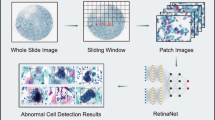Abstract
Objective:
To analyze the clinical and sonographic variables that predicts the success of labor induction.
Study design:
We studied the Bishop score, cervical length and parity in 196 pregnant women in the prediction of successful vaginal delivery within 24 h of induction. Logistic regression and segmentation analysis were performed.
Results:
Cervical length (odds ratio (OR) 1.089, P<0.001), Bishop score (OR 0.751, P=0.001) and parity (OR 4.7, P<0.001) predict the success of labor induction. In a global analysis of the variables studied, the best statistic sequence that predicts the labor induction was found when we introduced parity in the first place. The success of labor induction in nulliparous was 50.8 and 83.3% in multiparous women (P=0.0001).
Conclusions:
Cervical length, Bishop score and parity, integrated in a flow chart, provide independent prediction of vaginal delivery within 24 h of induction.
This is a preview of subscription content, access via your institution
Access options
Subscribe to this journal
Receive 12 print issues and online access
$259.00 per year
only $21.58 per issue
Buy this article
- Purchase on Springer Link
- Instant access to full article PDF
Prices may be subject to local taxes which are calculated during checkout

Similar content being viewed by others
References
American College of Obstetricians and Gynecologists. Induction of Labor. The College: Washington (DC), 1999, Practice Bulletin No: 10.
Gudex G . Induction of labour with prostaglandin E2 a prospective audit. NJ Med J 1993; 106: 78–80.
RCOG. Induction of labour. In Evidence-based Clinical guideline Number 9. RCOG Clinical Support Unit: London, 2001.
Pandis GK, Papageorghiou V, Ramanathan M, Thompson O, Nicolaides KH . Preinduction sonographic measurement of cervical length in the prediction of successful induction of labor. Ultrasound Obstet Gynecol 2001; 18: 623–628.
Boozarjomehri F, Timor-Tritsch I, Chao CR, Fox HE . Transvaginal ultrasonographic evaluation of the cervix before labor: Presence of cervical wedging is associated with shorter duration of induced labor. Am J Obstet Gynecol 1994; 171: 1081–1087.
Faltin-Traub EF, Boulvain M, Faltin DL, Extermann P, Irion O . Reliability of the Bishop score labour induction at term. Eur J Obstet and Gynecol Reprod Biol 2004; 112: 178–181.
Ware V, Raynor BD . Transvaginal ultrasonographic cervical measurement as a predictor of successful labor induction. Am J Obstet Gynecol 2000; 182: 1030–1032.
Watson WS, Stevens D, Welter S, Day D . Factor predicting successful labor induction. Obstet Gynecol 1996; 88: 990–992.
Chandra S, Crane JM, Hutchens D, Young DC . Transvaginal ultrasound and digital examination in predicting successful labor induction. Obstet Gynecol 2001; 98: 2–6.
Novakov-Mikic A, Ivanovich L, Dukanac J . Transvaginal ultrasonography of uterine cervix in prediction of the outcome of labour induction. Med Preg 2000; 53: 569–578.
Colombo DF, Iams JD . Cervical length and preterm labor. Clin Obstet Gynecol 2000; 44: 735–745.
Bland JM, Altman DG . Statistical methods for assesing agreement between two methods of clinical measurement. Lancet 1986; 1: 307–310.
Bland JM, Altman DG . Measuring agreement in method comparison studies. Stat Meth Med Res 1999; 8: 135–160.
Lemon SC, Roy J, Clark MA, Friedmann PD, Rakowski W . Classification and regression tree analysis in public health: methodological review and comparison with logistic regression. Ann Behav Med 2003; 26 (3): 172–181.
Bueno B, San Frutos L, Salazar F, Pérez-Medina T, Engels V, Archilla B et al. Variables that predict the success of labor induction. Acta Obstet Gynecol Scand 2005; 84: 1093–1097.
Rane SM, Pandis GK, Guirgis RR, Higgins B, Nicolaides KH . Preinduction sonographic measurement of cervical length in prolonged pregnancy: the effect of parity in the prediction of induction-to-delivery interval. Ultrasound Obstet Gynecol 2003; 22: 40–44.
Gabriel R, Darnaud T, Chalot F, Gonzalez N, Leymarie F, Quereux C . Transvaginal sonography of the uterine cervix prior to labor induction. Ultrasound Obstet Gynecol 2002; 19: 254–257.
Valentin L, Bergelin I . Intra and interobserver reproducibility of ultrasound measurements of cervical length and width in the second and third trimesters of pregnancy. Ultrasound Obstet Gynecol 2002; 20: 256–262.
Burger M, Weber-Rösser T, William M . Measurement of the pregnant cervix by transvaginal sonography: an interobserver variability. Ultrasound Obstet Gynecol 1997; 9: 188–193.
Vayssière C, Morinière C, Camus M, Le Strat Y, Poly L, Fermanian J et al. Measuring cervical lenght with ultrasound: evaluation of the procedures and duration of a learning method. Ultrasound Obstet Gynecol 2002; 20: 575–579.
Author information
Authors and Affiliations
Corresponding author
Rights and permissions
About this article
Cite this article
Bueno, B., San-Frutos, L., Pérez-Medina, T. et al. The labor induction: integrated clinical and sonographic variables that predict the outcome. J Perinatol 27, 4–8 (2007). https://doi.org/10.1038/sj.jp.7211619
Received:
Revised:
Accepted:
Published:
Issue Date:
DOI: https://doi.org/10.1038/sj.jp.7211619
Keywords
This article is cited by
-
Clinical predictive factors for vaginal delivery following induction of labour among pregnant women in Jordan
BMC Pregnancy and Childbirth (2021)
-
Placental and maternal serum activin A in spontaneous and induced labor in late-term pregnancy
Journal of Endocrinological Investigation (2018)
-
Labour induction at term: clinical, biophysical and molecular predictive factors
Archives of Gynecology and Obstetrics (2012)



